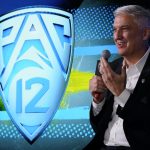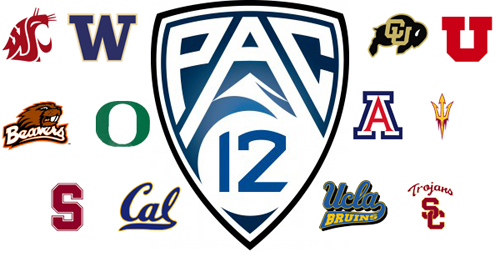The Hotline mailbag is published each Friday. Send questions to pac12hotline@bayareanewsgroup.com or hit me on Twitter: @WilnerHotline. Due to volume — and in some cases, the need for research — not all questions will be answered the week of submission. Thanks for your understanding.
Some questions have been edited for clarity and brevity.
What’s more important to the Pac-12: total TV revenue, or the gap in TV revenue with the other Power Five conferences? So, would a Pac-12 school 1) choose $30 million per year in TV revenue as long as the SEC and Big Ten were also at $30 million, or 2) choose $60 million per year but with SEC and Big Ten at $120 million? — @troyboy8ball
Good question — one that, admittedly, I have never posed directly to an athletic director. But revenue strikes us as a relative, not absolute, situation.
The Pac-12 is competing in the same marketplace as the Big Ten and SEC for head coaches, assistant coaches/coordinators and recruits.
And at least four of the schools (the California quartet) are dealing with a cost-of-living sandbag strapped to their backs.
For that reason, the so-called revenue gap is more important — more detrimental — than the total revenue. The conference would be vastly better off with lower total revenue and no disparity with other leagues than with more total revenue and a massive disparity.
In that case, it would only face a cost-of-living challenge.
Right now, it’s collecting less in revenue and has to deal with local economic conditions.
Will the Pac-12’s new media deal have a chance at getting close to the Big Ten’s new deal? — @brianoscarson
Depends on how you define “close.”
Currently, the Big Ten distributes about $55 million annually to each school while the Pac-12 hands out approximately $35 million (in non-pandemic years).
Those figures flow from three primary revenue streams: media deals for football and basketball regular-season broadcasts; the NCAA Tournament; and the College Football Playoff.
The media deals vary by the league and account for an outsize portion of the overall distribution, while the NCAA and CFP revenues are essentially the same across the Power Five.
In other words, the Big Ten’s $20 million (or 57 percent) advantage over the Pac-12 is rooted in bigger and better media deals for its Tier I rights and the Big Ten Network.
That won’t change when the Big Ten begins its new contract cycle in 2023 and the Pac-12 follows in 2024.
If anything, we expect the Big Ten’s advantage to increase. Why? Because media consumption has changed.
It’s no longer about the number of cable homes in your footprint; it’s about the number of marquee football matchups you can offer — matchups that draw more than four or five million viewers.
In part because of the ratings machine known as Ohio State, the Big Ten has a massive advantage in that regard.
Have the Alliance commissioners given up on a scheduling alliance? — @TerryTerry79
They have not given up, but each conference is on a different timeline with that piece of their partnership.
The ACC already plays four non-conference games. The Big Ten is debating whether to play four non-conference games, and the Pac-12 is ready to switch to four non-conference games the moment the Big Ten makes its move.
If the Big Ten and Pac-12 stick with their existing models — and it sure looks that way in the Big Ten — then Alliance games will be added to future schedules when the opportunity exists.
Keep in mind that the Pac-12 already has dozens of games scheduled against the Big Ten — and the SEC, for that matter — over the next decade.
(Details here.)
Who is your dark horse team (not Arizona, USC or UCLA) to win the Pac-12 tournament? And if you are already in the NCAA Tournament field, is it better to win your conference tournament or to lose and have extra days off? — @Robservatory
We’ll address the second piece of that next week, but I generally believe the rest is more important.
As for the issue of sleeper teams in Las Vegas, the Hotline has two favorites: Colorado and Arizona State.
The Buffaloes are extremely well coached and have a nice mix of pieces, especially with freshman point guard KJ Simpson and forward Jabari Walker, who is capable of carrying CU to multiple victories.
Arizona State is simply a momentum play. After struggling for months, the Sun Devils have discovered their rhythm and confidence offensively and should enter the tournament with seven wins in eight games.
The problem for both ASU and Colorado is this: The top of the conference is stronger than it was in 2021, when Oregon State got hot and reeled off four consecutive wins.
A dark horse likely would need to beat USC or UCLA and Arizona to win the tournament.
That’s a steep challenge.
What’s the biggest issue with Jerod Haase at Stanford? He seems to recruit well, but players don’t improve under him. Is that the staff? — @georgemalone
Haase has recruited well — extremely well — and the Cardinal usually plays decent defense. The problem throughout his tenure has been the offense.
Stanford doesn’t have a visible plan of attack and is too easy to defend, especially in the second half of league play (once teams develop comprehensive scouting reports).
Want proof? Consider the Cardinal’s national placement in the Pomeroy offensive efficiency rankings during each season under Haase:
2017: No. 161
2018: No. 120
2019: No. 187
2020: No. 143
2021: No. 110
2022: No. 148
Six years, and not once has the Cardinal placed in the top-100. That speaks to a systemic problem, and systemic problems are absolutely tied to the coaching staffs.
I’m not sure how many more chances Haase should get.
How did you whiff so badly on Arizona basketball? — @TucsonAri
You hit some, you miss some.
You hit some big; you miss some big.
If being wrong bothered me, I wouldn’t offer predictions on the conference race. I wouldn’t publish top-25 projections eight months before the season, and I wouldn’t predict the outcome of every Pac-12 football game.
That said, this was a big miss — an all-time bad call, in fact.
I didn’t foresee the meshing of existing talent with new coach Tommy Lloyd’s system or the development of big man Christian Koloko, the key to so much of what the Wildcats have accomplished on both ends.
From our vantage point, the situation is akin to the Golden State Warriors replacing Mark Jackson with Steve Kerr.
In both cases, the switch from a veteran coach who prefers a grinding style of play to a rookie coach who favors a free-flowing system — one based on spacing and ball movement — unlocked the returning talent.
A reporter here in southern California has implied a bit of tension between USC coach Andy Enfield and athletic director Mike Bohn. What do you think the chances are that Enfield moves on after the season? — Kent Hollenback
I don’t have direct knowledge of “tension” but would suggest the three-year extension Enfield reportedly received probably wasn’t seen as an ideal level of security from his camp.
Of course, Enfield would only leave USC for a better offer, which means the right jobs have to open. At this point, Maryland is likely atop the list — Enfield grew up in Pennsylvania and attended Johns Hopkins (in Baltimore).
Should any Power Five school pursue Enfield, the Trojans seemingly would have two options:
Make a solid-but-not-spectacular offer to satisfy their constituents; or open the vault and do everything possible to keep him.
Has Enfield done enough to warrant opening the vault? You could make that case, sure. But because of basketball’s secondary position at USC, we wonder if the school believes any basketball coach is worth top dollar.
The next three weeks will shape the coaching carousel and, perhaps, Enfield’s market value.
If USC returns to the Sweet 16, he will have significant leverage.
Support the Hotline: Receive three months of unlimited access for just 99 cents. Yep, that’s 99 cents for 90 days, with the option to cancel anytime. Details are here, and thanks for your support.
*** Send suggestions, comments and tips (confidentiality guaranteed) to pac12hotline@bayareanewsgroup.com or call 408-920-5716
*** Follow me on Twitter: @WilnerHotline
*** Pac-12 Hotline is not endorsed or sponsored by the Pac-12 Conference, and the views expressed herein do not necessarily reflect the views of the Conference.
Related posts:
 Wilner Hotline – Pac-12 on the brink: USC and UCLA expected to seek membership in the Big Ten
Wilner Hotline – Pac-12 on the brink: USC and UCLA expected to seek membership in the Big Ten
 Pac-12 survival: What to make of Big Ten expansion plans, Oregon’s search for an escape hatch and the Big 12 option
Pac-12 survival: What to make of Big Ten expansion plans, Oregon’s search for an escape hatch and the Big 12 option
 Pac-12 survival: Why the conference should follow the CFP’s lead and expand
Pac-12 survival: Why the conference should follow the CFP’s lead and expand

(AP Photo/Marcio Jose Sanchez)
Business of Sports-Pac-12 collapse: Pac-12 Network production studio an asset or liability?Jon Wilner
Jon Wilner has been covering college sports for decades and is an AP top-25 football and basketball voter as well as a Heisman Trophy voter. He was named Beat Writer of the Year in 2013 by the Football Writers Association of America for his coverage of the Pac-12, won first place for feature writing in 2016 in the Associated Press Sports Editors writing contest and is a five-time APSE honoree.
